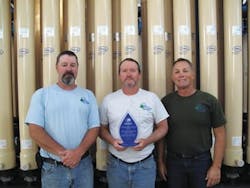Back in Season
About the author: Pete O’Connell is regional manager for Pall Water. O’Connell can be reached at [email protected].
Left to right: Row River Water Treatment Plant operators Steve Norman, Sam Haynes and Ray Pardee receive the Outstanding Membrane Plant Award: Small Facility from the Northwest Membrane Operator Assn.
The Row River Water Treatment Plant in Cottage Grove, Ore., serves a population of approximately 10,000 people, utilizing almost 4,000 connections over an approximately 4-sq-mile service area with 49 miles of water main. The Row River historically served as a supplemental water supply to the city’s primary 2-million-gal-per-day (mgd) Layng Creek Water Treatment Plant to meet system demands during peak demand periods, which were typically during the summer months.
The original Row River Water Treatment Plant was constructed in 1993 with a capacity of 2 mgd. It used an upflow clarifier with a multimedia rapid sand filter. The plant was built to expand to 4 mgd and then again to 6 mgd with few additions to infrastructure.
In 2006, the Cottage Grove City Council voted to discontinue the use of the Layng Creek Water Treatment Plant. The treatment plant and approximately 25 miles of 14-in. finished water transmission steel pipeline had reached the end of their useful life and could not keep up with demand. The city extensively researched replacing the Layng Creek Water Treatment Plant with a new facility and pipeline due to a limited summer source of water supply from Layng Creek; however, the costs for the infrastructure replacement did not warrant the limited return on investment.
City officials were tasked with renovating and developing additional water production capacity at the Row River Water Treatment Plant. The solution not only needed to be capable of meeting drinking water standards, but also needed to handle Cottage Grove’s capacity requirements, as water use frequently triples during summer. Additionally, facility operators needed to find a treatment method they could trust, as constant monitoring of the water supply and treatment were paramount.
The Aria FLEX membrane filtration system after installation at the Row River Water Treatment Plant in Cottage Grove, Ore.
Flexible System
Facility operators ultimately selected the Aria FLEX membrane system, which uses pressurized filtration membranes to meet drinking water standards. This system was selected because it fits a range of capacities and meets treatment and flow rate demands.
Following implementation, the Row River Water Treatment Plant’s new gravity-fed intake system met feed demand as it transitioned from 2 to 4 mgd. Ultimately it will produce 8 mgd for the full build-out of the water treatment plant. Operators plan to further expand the plant in the next budget year with the addition of more membranes.
The flexibility of this system allows the Row River Water Treatment Plant to operate at increased capacity during peak demand when capacity triples in the summer. “With our old system, it took several days to ramp up capacity, but now with the Pall system, we are able to ramp up capacity almost instantaneously, going from 2 to 4 mgd in a matter of minutes,” said Steve Norman, one of the plant operators.
The new system also has solved previous capacity woes with the now-shuttered Layng Creek Water Treatment Plant.
“Now we are able to treat any kind of water, no matter the conditions,” said Sam Haynes, another plant operators. “Our original 1993 Row River Water Treatment Plant’s system slowed to a halt and operated at a reduced capacity of 50%, only able to produce 1 mgd any time turbidity exceeded 20 ntu. With Pall Water, we can run at full capacity with any water, even at more than 100 ntu, unless it’s mud.”
Streamlining Operations
The fully integrated membrane system removes all matter greater than 0.1 µ. Most commonly, this system treats Giardia, Cryptosporidium and bacteria ranging from 0.2 to 50 µ. The system also enables a clean-in-place cycle every 60 days. This efficiency has led to annual savings of $5,500 for the facility, as its need for chlorine and other water chemicals has decreased. This efficiency also has led to a noticeable savings each month in operator time.
The operator-friendly nature of the system was a major benefit. The previous method required an operator to be on site at all times to monitor the water treatment processes, while others were on call 24/7.
“Before this retrofit, we were operating with the help of circular chart recorders [and] we had to be on site to monitor plant performance and make even the slightest adjustment,” Haynes said. “Our new treatment system has SCADA so we are now able to monitor the plant remotely. This has been a huge benefit, as we recently experienced a storm that brought heavy snowfall, ice and rain. In minutes, we went from 10 to 75 ntu, yet I had complete control of the plant from my laptop and was able to adjust the coagulant, oxidizer, pre-strainers and pressures.”
Those changes also are recorded in the system, and the complete history can be accessed the next morning at the plant, Haynes added.
Following deployment, Pall Water’s flexible membrane unit fulfilled the water quality needs of the facility, allowing it to meet drinking water requirements while delivering on the plant’s water capacity needs. The system also simplified day-to-day operations and provided a trustworthy water treatment solution.
“While there was some initial reluctance from operators when we transitioned from our traditional, manually operated water treatment plant to the SCADA-controlled Aria FLEX system, this quickly changed,” said Ray Pardee, water production superintendent in Cottage Grove. “After having some experience with the system, you couldn’t get the operators to change back for anything; they love it.”
